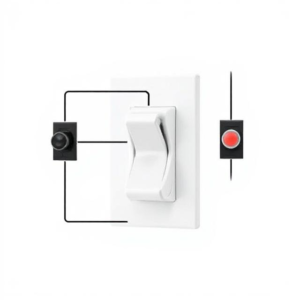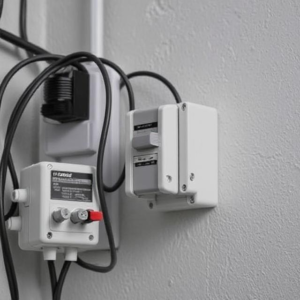What is Circuit Protection?
Circuit protection is all about keeping electrical circuits and components safe from damage caused by excessive current, voltage, or other harmful conditions. Circuit protection components are used to prevent electrical devices from being damaged by things like power surges, short circuits, or overloads.
These components act like “safety devices” to protect circuits from harmful electrical conditions, ensuring that your gadgets and electrical systems keep working smoothly.

Types of Circuit Protection Components:
- Fuses:
- A fuse is a small device that protects circuits by breaking (blowing) when the current becomes too high.
- It’s like a safety switch that shuts off the flow of electricity if it gets too dangerous.
How it works:
The fuse contains a thin wire that melts when the current exceeds a certain limit, cutting off the electrical flow. Once the fuse blows, you need to replace it.Example:
In a toaster, if the current gets too high due to a malfunction, the fuse will blow to prevent the toaster from catching fire.Pros:
- Simple and inexpensive.
- Protects against overcurrent.
Cons:
- Once it blows, you need to replace it.
- Circuit Breakers:
- A circuit breaker is similar to a fuse but it can reset and be used again after it trips.
- It’s a switch that automatically turns off a circuit when it detects an overload or short circuit.
How it works:
When the current is too high, the circuit breaker trips, physically separating the contacts inside. After fixing the issue (like fixing a short circuit), you can flip the breaker back on.Example:
In your home, if too many devices are plugged into the same power strip, the circuit breaker in your electrical panel might trip to prevent overheating or fires.Pros:
- Can be reset and reused.
- Ideal for protecting high-voltage circuits.
Cons:
- Can be more expensive and complex than a fuse.
- Surge Protectors:
- A surge protector is a device that protects electronic devices from voltage spikes (short bursts of high voltage).
- These spikes are often caused by things like lightning storms or power grid issues.
How it works:
Surge protectors have a special component (often a MOV—Metal Oxide Varistor) that absorbs the extra voltage and redirects it safely to the ground.Example:
If there’s a power surge from a lightning strike, a surge protector will stop the spike from damaging your computer or TV.Pros:
- Protects sensitive electronics like computers, phones, and appliances.
- Often comes with multiple outlets to protect multiple devices at once.
Cons:
- May wear out over time after multiple surges.
- Thermistors:
- A thermistor is a type of resistor that changes its resistance with temperature.
- NTC thermistors (Negative Temperature Coefficient) decrease resistance as they heat up, while PTC thermistors (Positive Temperature Coefficient) increase resistance as they heat up.
How it works:
When the circuit gets too hot (because of excessive current), the thermistor increases its resistance, limiting the current flow and preventing damage.Example:
In power supply circuits, thermistors are often used to prevent overheating.Pros:
- Automatically adjusts to protect the circuit.
- Ideal for overcurrent and overheating protection.
Cons:
- May not be as effective for extreme overload situations as fuses or circuit breakers.
- Varistors:
- A varistor is a component that protects against voltage spikes (like a surge protector) but works at a broader range of voltages.
How it works:
A varistor has a resistance that changes based on the voltage. If the voltage goes too high, the resistance drops, allowing the excess voltage to be safely diverted.Example:
Varistors are commonly used in power strips and electrical appliances to protect against surges.Pros:
- Helps protect against high-voltage spikes, like those caused by lightning.
- Fast response time.
Cons:
- Can degrade over time after multiple surges, requiring replacement.
- Overvoltage Protection Diodes:
- Zener diodes and other special diodes are used for overvoltage protection.
- These diodes allow current to flow in the normal direction but block or redirect excess voltage when it goes above a certain threshold.
How it works:
When the voltage exceeds a safe limit, the diode conducts and shunts the excess voltage away from sensitive components.Example:
Zener diodes are commonly used in power supplies to keep the voltage from exceeding a certain level.Pros:
- Effective for protecting against high voltage.
- Compact and reliable.
Cons:
- Only protects against voltage spikes, not other issues like overloads.
Why Circuit Protection is Important:
- Prevents Damage: Without protection, high currents, voltage spikes, or overheating can damage or destroy electrical components.
- Safety: Proper circuit protection prevents fires, electric shocks, or other dangerous situations.
- Extends Device Lifespan: Protection keeps electrical devices working longer by preventing wear and tear from excessive electrical stress.
- Compliance: Many electrical devices are required by law to have certain types of protection to meet safety standards.
Summary:
Circuit protection components are like safety shields for electrical circuits, protecting devices from excessive current, voltage spikes, and overheating. Common protection components include:
- Fuses: Blow when current is too high, cutting off the power.
- Circuit Breakers: Automatically turn off and can be reset when an overload occurs.
- Surge Protectors: Protect devices from voltage spikes, like those caused by lightning.
- Thermistors: Control current by adjusting resistance when the circuit gets too hot.
- Varistors: Protect against voltage spikes by diverting excess voltage.
- Overvoltage Protection Diodes: Block excess voltage to protect sensitive components.











